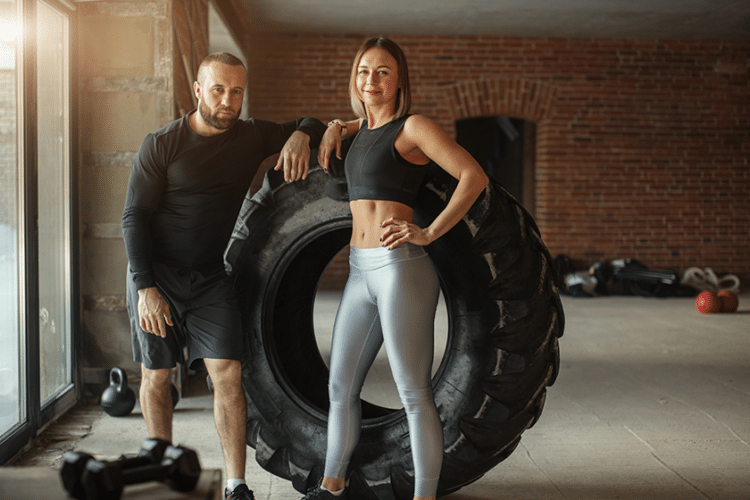
For a personal trainer, there is so much more to the gym outfit than looking fashionable. If you get it right, your outfit has the potential to make the right impression and positively influence perception, performance and attitude.
This guide will help you understand the benefits of choosing the right personal trainer outfit and outline tips for making the best choice.
Why Does Your Personal Trainer Outfit Matter?
Wearing the right gym clothing has numerous physical, psychological, and professional benefits including:
- Functionality: The right outfit allows for a full range of motion when demonstrating exercise moves and techniques. Flexible and comfortable clothing designed for athletic performance makes it easy to squat, bend, lift weights, jump, or stretch without restricting movement.
- Projecting a Professional Image: Just as in any professional setting, appropriate clothing can go a long way in creating a favorable first impression in the gym. Wearing the right attire projects a sense of professionalism and can make it easy for clients to look up to you for advice and guidance.
- Injury Prevention: The right gym attire can minimize the risk of injury while working out. For example, supportive footwear and compression gear provides the support and flexibility required for intense workouts.
- Sweat Control: Wearing clothing made from moisture-wicking and highly absorbent materials helps you stay cool and dry for the duration of your workout session. This can boost performance as it makes the session more enjoyable.
- Setting Your Brand Apart: You are your own best brand ambassador. Your choice of attire can serve as a subtle advertisement for your business, attracting clients and setting your brand apart in a competitive industry.
What To Wear for a Workout
Now that we understand the importance of choosing the right attire, let us get into how to look and feel your best during workouts:
- Footwear
High-quality training shoes will give you adequate support and comfort during workouts. Remember to pick a pair that is designed specifically for the workout you are engaged in.
When engaging in high-impact activities such as running, choose a light and supportive pair of sneakers with adequate cushioning. Strength training requires a stable shoe with a flat base and minimal arch support. Cross-trainers are ideal for the gym because they offer flexibility and lateral support.
- Tops
For women, sports bras are a fundamental part of your outfit, providing the necessary support to minimize movement and pain in the chest area. A good sports bra should be made of breathable material such as spandex and cotton. Choose one that fits snugly but does not obstruct breathing or movement.
Men should wear fitted or semi-fitted t-shirts or tank tops that allow freedom of movement and do not restrict your range. Tops with a slight stretch and ergonomic seams are particularly ideal for comfort. Make sure your choice of top does not absorb moisture.
- Bottoms
Choose your workout bottoms based on the type of workout and the amount of coverage you desire. Lightweight joggers or shorts offer ventilation and flexibility and are therefore ideal for outdoor activities and intensive cardio workouts.
Tights are another great option offering flexibility and allowing for a full range of motion. They come in a variety of lengths and styles to suit varying style preferences and workout regimens.
- Outerwear
During cold seasons, go for a lightweight hoodie or jacket in a moisture-wicking fabric to get warmth without the risk of overheating. Layering allows you to adjust to different phases of warm-up and cool-down sessions and to adapt to changes in temperature during the workout.
- Accessories
Gym accessories are an important part of your personal trainer outfit as they provide perspiration control, protection, and comfort, optimizing performance. Some of the important items to include here are:
- Wrist Straps: Protect your wrists when lifting weights to reduce the strain on your forearms and provide extra grip strength.
- Knee Sleeves: For workouts involving lunges and squats, use knee sleeves for support and stability to minimize the possibility of joint pains or injury.
- Socks: To maintain comfort in your feet, wear breathable socks made from acrylic or an acrylic blend.
- Hair Slips or Bands: Keep your hair from getting in the way and avoid unnecessary interruptions with the right hair slips or bands.
Factors to Consider When Choosing Your Outfit
- The Training Environment
One of the factors that should determine your choice of clothes is the environment where you are planning to train. For outdoor workouts, take into account the weather and protect yourself adequately from the elements. If necessary, dress in layers to accommodate changes in temperature.
If you are training in a private studio or home gym, focus on comfort and functionality since this environment is more controlled.
In indoor gyms, which are typically warm, choose lightweight clothing with moisture-wicking properties and high breathability to stay cool throughout the session.
- Fabric Type and Quality
The best fabric for fitness clothing should have a blend of properties including durability, ease of care, moisture-wicking, and breathability. Some of the most popular fabrics include:
- Nylon: Flexible, easy to care for, and wrinkle-resistant.
- Polyester: Lightweight, durable, breathable, wrinkle-resistant, great insulation, and moisture-wicking.
- Spandex: Extremely stretchy and flexible, moderate moisture-wicking and breathable.
- Natural fibers: High breathability, hypoallergenic, and moisture management properties.
In many cases, fitness clothes are made from a blend of two or more of the above fabrics to balance the pros and cons and provide optimal performance.
- Comfort
The clothes you choose should help you focus on the workout activity rather than keep you preoccupied with your appearance. Avoid any outfit that makes you feel self-conscious.
- Hygiene and Appearance
Always keep your workout outfit clean to prevent the accumulation of long-term odors. Note that sweat creates an environment where microorganisms such as bacteria can thrive and produce odor.
Cleaning your clothes right after a workout reduces the risk of lingering odors. Heat effectively kills bacteria, but be careful not to use too much heat as this can cause your clothes to lose shape, shrink, or expand.
Remember to replace damaged or ripped clothes as these would make a poor impression
Setting the Best Foundation for Personal Training Success
Your professional personal trainer outfit choice is just one of many factors that can drive success in your personal fitness journey. At the foundational level, the most important consideration is to get the best possible education and certification in the art and science of personal training.
The National Personal Training Institute, Inc. has carved out a niche for providing top-notch training in this field. We are a veteran-owned and operated institution offering a licensed and accredited diploma program in personal fitness training. For certified personal trainers, we offer advanced personal fitness courses that deliver holistic hands-on training to hone your current skills.
The right qualifications and certification coupled with presentable outfit choices are an important part of the formula for success in personal training. Together, you can project the right professional image and confidently deliver excellent training to your clients.

